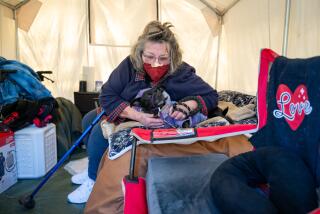Ojai Moves to Balance Tourism, Rural Lifestyle
- Share via
OJAI — A year after trying to attract more visitors to this self-styled Shangri-La by inaugurating a first-ever, city-financed marketing plan, cautious municipal leaders have decided to pull back a little.
In approving the second year of the promotional effort, the Ojai City Council on Tuesday broadened the plan to incorporate helping businesses that don’t cater primarily to tourists, particularly those whose employees would telecommute.
In addition, the revised marketing plan will explicitly state that the rural community’s objective is to balance tourism with a concern for the quality of life that its 8,000 residents cherish, partly by encouraging steps to reduce visitors’ dependence on automobiles during their stay.
“My concern, in essence, was balance,” said Councilwoman Nina Shelley, who added that the shift may not be universally popular in a town that relies heavily on visitor dollars. “I hope it will call attention to the fact that we need to focus on other things as well as tourism. I probably won’t go to the Chamber of Commerce mixer next time.”
The shift suggests that old concerns about encroaching urban hordes of camera-toting tourists remain, despite the marketing overtures of the last year.
“I didn’t see any warning flags go up then, as I did this year,” Shelley said. “I’ve come to the point where I just stay out of the downtown area on weekends. It isn’t the people per se, it’s just the crowding.”
A similar attitude prevailed a decade ago during the booming 1980s. In 1987, after an attempt to form a countywide tourism plan fell apart, then City Manager Geoff Grote told The Times that Ojai was struggling to accommodate its burgeoning number of visitors and no community consensus existed on whether more should be attracted.
Still, in a region that has vigilantly protected its rural charm, officials are cautiously calling the initial year of Ojai’s tourism marketing plan a good, albeit modest, beginning.
The $15,000 promotional effort financed an invitation-only soiree in West Hollywood for travel writers, enabled the Chamber of Commerce to hire a staff person solely to handle visitor inquiries, and paid to establish a Web site on the Internet to promote the Ojai Valley. The result was a small increase in the number of visitors, especially midweek, which was sought in an attempt not to add to the city’s clogged thoroughfares on weekends.
“Overall, our sales taxes and bed taxes are up more than 5%,” said City Manager Andy Belknap, who added that an improving economy has also undoubtedly played a role in rising tourism. “This is the beginning of an attempt to develop a more formal marketing program.”
Exactly how a marketing program aimed at luring more visitors dollars will be altered to accommodate non-tourism businesses has yet to be decided. A similar amount will be spent for the fiscal year beginning July 1.
The expanded focus of next year’s plan has resurrected the uneasy balance between those who rely on the infusion of cash from visitors and residents who value unclogged streets and the valley’s rural tranquillity. It is, concedes Belknap, a delicate balancing act.
Pat Nichols, owner of Pink Moment Jeep Tours, said midweek business for the 3 1/2-hour sunset drives in the Topatopa Mountains jumped 25% as a result of a discounted travel package that was developed as part of the marketing plan. She said she would like to see more money spent on attracting visitors, but is wary of offending locals.
“You walk down Ojai Avenue and it’s like Malibu in the mountains, I’ve heard people say,” Nichols said. “It’s a tourist town whether Ojai wants to admit it or not.”
Dietrich Pahnke, general manager of the Oaks at Ojai health and fitness resort, doesn’t believe the marketing plan’s subtle evolution will hurt its effectiveness.
“I think visitor activity needs to be managed,” he said. “Our business is ideally located in a community that is so much environmentally oriented, and our guests like that very much. . . . Our guests come here, park their car and never use it again until they leave.”
More to Read
Sign up for The Wild
We’ll help you find the best places to hike, bike and run, as well as the perfect silent spots for meditation and yoga.
You may occasionally receive promotional content from the Los Angeles Times.






